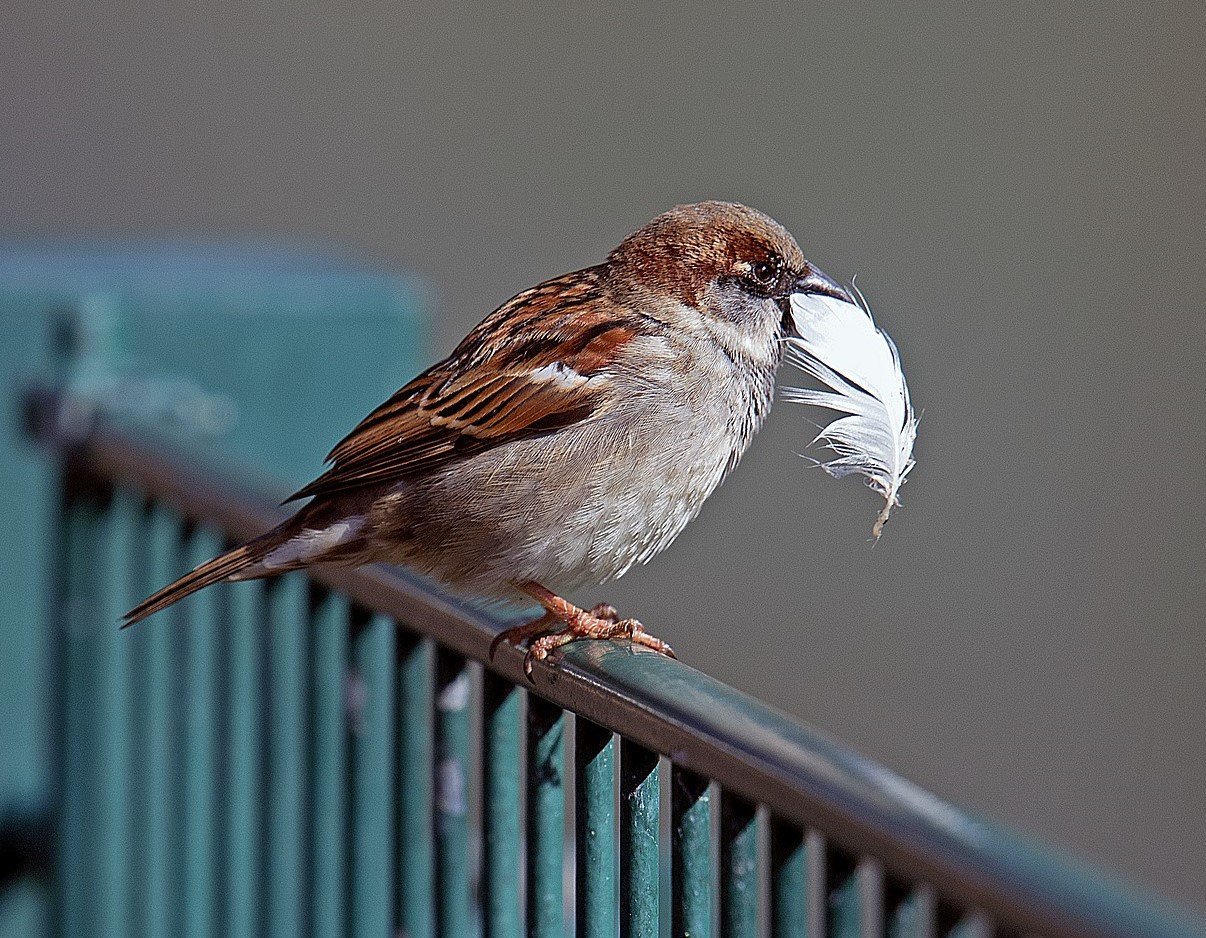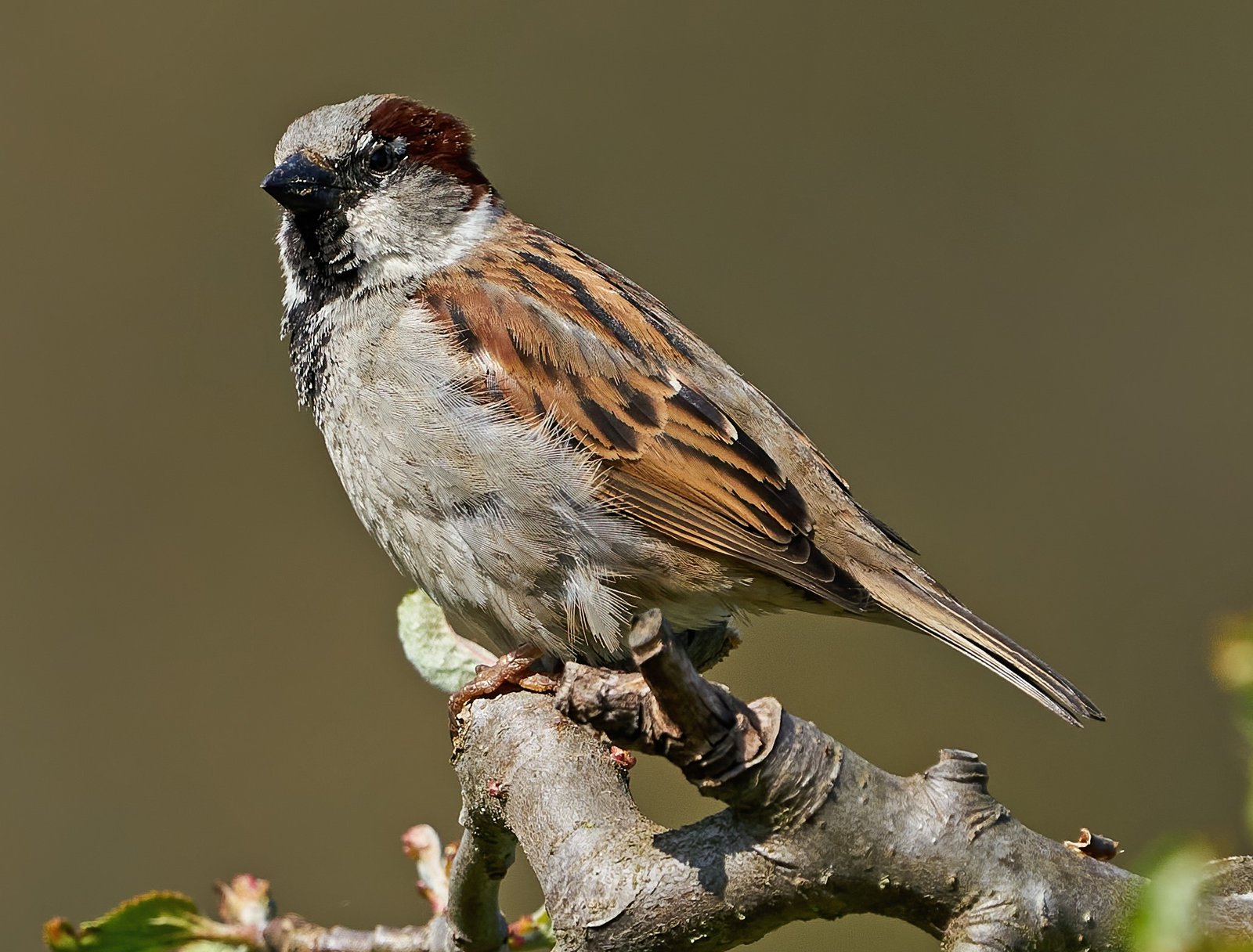House Sparrow: Passer Domesticus

The House Sparrow is a sparrow from the Old World introduced to Brooklyn, New York, in 1851. It found plenty of food in the manure left behind by horse-drawn carriages, as well as plenty of breeding sites in man-made structures, and by 1910 had spread across the United States.
This bird native to most of Europe and much of Asia. It has been introduced to most of Central and South America, Sub-Saharan Africa, New Zealand, and Australia, either intentionally or accidentally. It is now the world’s most widely distributed wild bird. The House Sparrow is a very violent bird that preys on other species’ nesting sites, and it’s seen as a nuisance bird species.
Learn More: Nuisance Birds
Description Of The House Sparrow
The common House Sparrow is a small, stocky songbird equipped with a gray chest, thick bill, and streaky colored back. The male House Sparrow is red on its back, white cheeks, a white wingbar, and a black bib found on the bird’s throat. In the winter, buffy tips on the throat feathers partially conceal the black bib (these tips wear off in the spring). Overall, the female is a dingy brown with a large buffy eye stripe. 1Go To Source tn.gov -“House Sparrow, Passer domesticus”
House Sparrow Size
Average measurements for the House Sparrow:
- Body Length: 14-18 cm
- Beak Length: 1.1–1.5 cm
- Tail Length: 5.2–6.5 cm
- Wing Chord Length: 6.7–8.9 cm
- Wingspan: 19–25 cm
- Feet Length: 1.6–2.5 cm
- Weight: 24 to 39.5 g
Habitat Of House Sparrows
This species can be found in a wide variety of environments. Grasslands, forests, meadows, deserts, desert edges, woodlands, and other natural habitats are among the places they call home. The majority of House Sparrows are found in cities.
They can be found in parks, cities, suburbs, backyards, farms, orchards, and various other man-made environments. The main reason they are such a successful invasive species is because of their adaptability.
House Sparrow Range & Distribution

Originally, the house sparrow was found in Eurasia, North Africa, and the Middle East. House sparrows are currently found in North America (except in the far north and Alaska), the subtropical region of South America, southern and northern Africa, the Middle East, Europe, Eurasia, central China, much of India, the western part of Southeast Asia, and southeastern Australia.
In North America, eight pairs of were released in Brooklyn, New York, in the spring of 1851. The Cincinnati Acclimatization Society introduced house sparrows between 1872 and 1874. In the years after the first release in 1851, numerous similar introductions occurred. Small numbers were collected within the United States and transported to other parts of the country, resulting in house sparrows’ establishment throughout the lower 48 states. 2Go To Source columbia.edu -“House Sparrow (Passer domesticus)”
Behavior Of House Sparrows
When not in flight, House Sparrows forage for food on the ground with a hopping motion. Their flight is direct, with no gliding and continuous flapping.
Household Sparrows defend a small territory around their nesting site with vigor. This is thought to be solely for the protection of the nesting site, not any feeding areas. Sparrows have been observed threatening and attacking 70 different bird species that have entered their nesting territory. Males appear to be attacking males, while females appear to be attacking only females. 3Go To Source animaldiversity.org -“Passer domesticus house sparrow”
House Sparrow Nesting Habits
House Sparrows’ nesting habits play a significant role in the birds’ life and activities. Because these birds use the nest almost all year. The birds use the nest to raise young in the spring and summer, raising up to four broods per season. It can be used for resting during the day and roosting at night in the fall and winter.
The nest can be found in any available location near human habitation, including buildings, trees, and birdhouses. The adaptability of this bird and the number of broods it can raise allow it to multiply in numbers. The construction of the nest takes place almost all year.
From February to May, you’ll likely notice the most nest-building activity. Some renovations may be carried out in the fall. The most important one occurs in the spring, just before breeding. Both the male and female contribute to nest construction.
The nest is spherical in shape with an outside diameter of 8 to 10 inches. It is made of coarse material such as straw, twigs, paper, leaves, grasses, and any other available material on the outside. Feathers or fine grasses are used to line the inside.
Reproduction Cycle Of The House Sparrow

Each breeding season, House Sparrows form monogamous pairs. Between February and May, nests are constructed. House Sparrows build their nests in nooks and crannies inside and outside of buildings, as well as in coniferous and deciduous trees. Dry vegetation, feathers, strings, and paper are used to construct nests.
During the nesting period, eggs can be laid at any time. A clutch can contain one to eight eggs, with up to four clutches possible per nesting season. After the female lays all her eggs, the incubation process begins. Males and females both incubate the eggs for a few minutes at a time. The incubation period will last anywhere from 10 to 14 days. After the eggs hatch, both males and females regurgitate food for the young.
House Sparrow Diet
House sparrows eat grains and weed seeds in particular, but they are extremely adaptable to whatever foods are available in their environments. House sparrows eat berries, buds, grapes, other fruits, insects and other invertebrates, and even small vertebrates like lizards and frogs. Insects are essential for nestlings, and the timing and success of house sparrow reproduction is directly related to the availability of insects to adult sparrows.
Discarded human foods (bread, French fries, etc.) are also consumed opportunistically by these adaptable birds. Almost every fast food restaurant has a resident population of house sparrows that feed on the waste, discards, and handouts left by the customers. 4Go To Source dept.psu.edu -” Common Name: House Sparrow or English Sparrow”
Top 5 Disease & Parasites Carried By House Sparrows
- Internal parasites such as roundworms, tapeworms, and gape worms.
- External parasites such as ticks, fleas, mites, bed bugs, and lice.
- Salmonellosis and anthrax are bacterial diseases carried by House Sparrows that can affect both humans and animals.
- Sarcosporidiosis and coccidiosis primarily affect animals, toxoplasmosis, and chlamydiosis (psittacosis), affecting both humans and animals.
- Infectious diseases spread by mosquitoes, such as West Nile Virus, Eastern Equine Encephalitis, Western Equine Encephalitis, St. Louis Encephalitis, and Venezuelan Encephalitis.
House Sparrow As Pests

House sparrows have since evolved into a common pest bird that coexists with humans and relies heavily on them for food and nesting sites. The birds have been linked to the spread of more than 25 human and domestic animal diseases.
Furthermore, the feces of house sparrows deface and foul structures such as park benches, outdoor lunch tables, statues, and stair railings and contaminate walkways around buildings. Their uric acid excrement can even damage car paint.
Roof drains, gutters and downspouts are frequently clogged by house sparrow nests, resulting in roof leaks. Their flammable nests, which are made of grass, straw, feathers, hair, weeds and other dried plant materials, strings, and other miscellaneous flammable trash, can cause serious fires, especially when nests are found in electrical equipment, light fixtures, and around power lines and electrical substations.
Damage Caused By House Sparrows
House sparrow damage has forced homeowners to take action against the pest species. They destroy gardens by eating seeds, buds, flowers, and young garden vegetation such as peas and lettuces. They also harm cherry, peach, and pear trees.
If allowed to build nests, their acidic droppings can damage paint, clog gutters, and cause fires by nesting near electrical units, dryer vents, and even power lines. These birds will also rip apart roofing to gain access to the attic and build nests indoors. Once inside, the birds will produce mass amounts of dropping that will damage the attic’s structure/
The health of the family is more important than the health of the garden or the home’s health. House Sparrow droppings contaminate, hazard, and stink around walkways and structures, as well as anywhere under their perching, roosting, and nesting areas. Many livestock and human diseases or internal parasites can be carried and spread by sparrows and other pest birds. Fleas, lice, mites, and ticks are all examples. Other pest birds may carry these diseases and parasites, but the house sparrow is more likely to transmit them due to its abundance.
House Sparrow Trapping & Removal
Availability of roosting and nesting sites should be reduced to prevent sparrows from overtaking properties and causing unwanted damage. To reduce the risk of disease transmission, cover your skin and lungs when removing sparrow droppings. Limiting the pests’ favorite food sources, if possible, will also help to get rid of them.
While trapping and removing sparrows is possible, doing so without a comprehensive strategy that includes prevention strategies will only be effective in the short term. The birds will eventually reclaim their former positions. Contacting a wildlife professional like Animals Happen is a surefire way to get rid of sparrows completely.
Sources:
- “House Sparrow | State of Tennessee, Wildlife Resources Agency.” Tennessee Wildlife Resources Agency, Tennessee Wildlife Resources Agency, www.tn.gov/twra/wildlife/birds/grassland-and-shrub-birds/house-sparrow.html. Accessed 9 Mar. 2021.
- Neal, Monica. “Invasion Biology Introduced Species Summary Project – Columbia University.” Columbia University In The City Of New York, Columbia University, 25 Feb. 2002, www.columbia.edu/itc/cerc/danoff-burg/invasion_bio/inv_spp_summ/Passer_domesticus.htm.
- Roof, J. 2001. “Passer domesticus” (On-line), Animal Diversity Web. Accessed March 09, 2021 at https://animaldiversity.org/accounts/Passer_domesticus/
- Myerski, Ashley. “House Sparrow.” Penn State, The Pennsylvania State University, 14 July 2014, www.dept.psu.edu/nkbiology/naturetrail/speciespages/house_sparrow.html?
